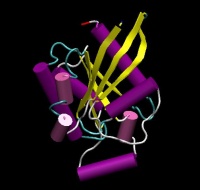Difference between revisions of "RhoA"
m |
m |
||
| Line 2: | Line 2: | ||
! {{infobox header}}| '''{{PAGENAME}}''' | ! {{infobox header}}| '''{{PAGENAME}}''' | ||
|- | |- | ||
| − | | align="center" colspan="2" bgcolor="#ffffff" | [[Image: | + | | align="center" colspan="2" bgcolor="#ffffff" | [[Image:RhoA.JPG|200px|{{PAGENAME}}]] |
|- | |- | ||
| Substrate peptide name | | Substrate peptide name | ||
Revision as of 08:19, 31 August 2007
| Template:Infobox header| RhoA | |
|---|---|

| |
| Substrate peptide name | RhoA |
| Synonyms | - |
| Determination type | In situ/In vitro |
| Source | Homo sapiens |
| Subcellular localization | Cytoskeleton |
| Swissprot ID | P61586 |
| Reactive glutamines | Q52, Q63, Q136 |
| Reactive lysines | - |
| Substrate sequence | EVDGKQVELAL
WDTAGQEDYDR LAKMKQEPVKP |
| Structure | 1A2B |
| Surface accessibility | ASAView pdf
ASAView txt |
| Disorder prediction | IUPred |
| Reference | PMID:9593707 |
| Notes | Q63 is deamidated/transamidated by TG2
The transamidated protein has increased binding affinity to ROCK-2. The deamidated form (by cytotoxic dermonecrotizing factor or BTX) has decreased GTPase activity. |
| Template:Infobox header | | |